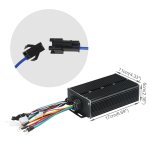I am looking at a hub motor with controller which says it has a single wire to switch between 250w street legal and 1500w off road. It has a blue wire with a plug, so assume when the plug is connected it is either 250w or 1500w, and vice versa when disconnected.
How would it do that? What is the connection inside the controller that would do that? Can all Chinese controllers do this with 1 wire?
Also, does anyone know what controller this is or could be?
It also comes with a simple throttle with tiny lcd so I will look at connecting a KT-LCD 8H display, so another question, will there be any problems hooking the controller up to the KT lcd8h or KT lcd3?
LINK:
https://www.googleadservices.com/pagead/aclk?sa=L&ai=DChcSEwj97JOnoa3gAhXBNSsKHcQBATEYABAPGgJzZg&ae=1&ohost=www.google.com&cid=CAESEeD2BRoK_Qi5z7hK11FgK6-j&sig=AOD64_2l5e470Ezry0BRxk1BXtprCNofGg&ctype=5&q=&ved=2ahUKEwiwzYynoa3gAhWKeysKHR-7DKQQwg96BAgLEAc&adurl=https://rover.ebay.com/rover/1/705-139619-5960-0/2%3Fmpre%3Dhttps%253A%252F%252Fwww.ebay.com.au%252Fp%252F26-1000w-Rear-Wheel-48v-Electric-Bicycle-Bike-Motor-Conversion-Kit-Hub-Cycling%252F3011640951%253Fiid%253D122870595676%2526chn%253Dps%26itemid%3D122870595676%26targetid%3D468509338749%26device%3Dt%26adtype%3Dpla%26googleloc%3D9070845%26poi%3D%26campaignid%3D1669177334%26adgroupid%3D64318442093%26rlsatarget%3Dpla-468509338749%26abcId%3D1139236%26merchantid%3D7364522%26gclid%3DCjwKCAiA7vTiBRAqEiwA4NTO62URV98VJq_bxXmiK9AhBOjPf4ggni_ayNpv2V23GmVb2zNuvN5-WxoCz-4QAvD_BwE
View attachment 1
How would it do that? What is the connection inside the controller that would do that? Can all Chinese controllers do this with 1 wire?
Also, does anyone know what controller this is or could be?
It also comes with a simple throttle with tiny lcd so I will look at connecting a KT-LCD 8H display, so another question, will there be any problems hooking the controller up to the KT lcd8h or KT lcd3?
LINK:
https://www.googleadservices.com/pagead/aclk?sa=L&ai=DChcSEwj97JOnoa3gAhXBNSsKHcQBATEYABAPGgJzZg&ae=1&ohost=www.google.com&cid=CAESEeD2BRoK_Qi5z7hK11FgK6-j&sig=AOD64_2l5e470Ezry0BRxk1BXtprCNofGg&ctype=5&q=&ved=2ahUKEwiwzYynoa3gAhWKeysKHR-7DKQQwg96BAgLEAc&adurl=https://rover.ebay.com/rover/1/705-139619-5960-0/2%3Fmpre%3Dhttps%253A%252F%252Fwww.ebay.com.au%252Fp%252F26-1000w-Rear-Wheel-48v-Electric-Bicycle-Bike-Motor-Conversion-Kit-Hub-Cycling%252F3011640951%253Fiid%253D122870595676%2526chn%253Dps%26itemid%3D122870595676%26targetid%3D468509338749%26device%3Dt%26adtype%3Dpla%26googleloc%3D9070845%26poi%3D%26campaignid%3D1669177334%26adgroupid%3D64318442093%26rlsatarget%3Dpla-468509338749%26abcId%3D1139236%26merchantid%3D7364522%26gclid%3DCjwKCAiA7vTiBRAqEiwA4NTO62URV98VJq_bxXmiK9AhBOjPf4ggni_ayNpv2V23GmVb2zNuvN5-WxoCz-4QAvD_BwE
View attachment 1


